Using Positive Reinforcement In Sports

Author: Carolyn Savoy
Bio: Experience in effective coaching and leading to assist athletes and business persons to improve their performance.
Degrees Held: PhD
According to Kazdin (1989), reinforcement refers to an increase in the frequency of a response when that response is immediately followed by certain consequences. Positive and negative reinforcement increase a target behavior.
Positive reinforcement: An increase in the frequency of a response or behavior that is followed by a positive reinforcement.
- Studying for an exam is probably reinforced by a good grade.
- A child whines before going to bed and the parents let the child stay up later so the frequency of the whining will increase.
- Winning money at a slot machine usually increases the frequency of putting money into the machine.
In a sport setting, the coach positively reinforces good performance by giving praise to the athlete or team for reaching the desired behavior. Coaches often give reinforcement for movement toward the desired behavior. For example, a coach may be teaching a shot in basketball and the athlete is doing three of the five components correctly, so the coach praises the parts the athlete is doing well and offers corrections for the other components of the shot. In this way the athlete is motivated to improve because they feel they have made some progress.
Enter The Nation's Largest Prospect Database
Connect with thousands of D1, D2, and D3 college coaches across the U.S. and get evaluated for collegiate athletics!
Negative Reinforcement
Negative reinforcement: An increase in the frequency of a response by removing an aversive event immediately after the response has been performed.
An increase in the frequency of a response by removing an aversive event immediately after the response has been performed.
- Taking medicine to relieve a headache may be negatively reinforced by the termination of pain.
- Nagging by a coach may increase running faster or working harder by the athlete. The aversive event (nagging) is terminated by increasing the target behavior (working harder).
Punishment
Punishment: The presentation of an aversive event or the removal of a positive event following a response, which decreases the frequency of that response.
- Losing privileges after staying out past curfew.
- An NCAA division 1 women’s basketball coach kicked her team out of their lavish locker room because they were not performing up to the coach’s expectations. The team improved their performance and after one month were allowed back into their locker room.
*Some psychologists will say that punishment should not be used in the sport setting as it gives a negative feeling about activity. Of course, as seen in the example above, punishment can take many forms, with the ultimate goal that the athlete views the punishment as being fair for the action. Punishment that is not construed as fair can cause an athlete to lose trust in the coach.
Consequences For Good and Poor Performances
As a coach I employed consequences for good and poor performances during practice on a daily basis. I found it helped the athletes to stay motivated and focused. Every day we would do a layup drill (not necessarily the same one) for four minutes without defense. I asked the players if university athletes should make layups when no one was guarding them. They replied, “Of course”. Then I said that they would have to run a sprint up and back for everyone they missed. I asked them if it was fair. They said it was. Then the drill began. At first they missed 31 lay ups. They weren’t happy about that and they complained about the punishment. I reminded them that they said they should not miss uncontested layups with absolutely no defense on them. The problem of course is they were not focused on the task and therefore were not ready to practice. It happens often that players come to practice and are not ready to perform.
Drills And Exercises For Increasing Performance
Coaches complain about this quite often. After they started running their sprints with rest of course (I made them run 2 or 3 up and back sprints), I stopped them and asked for a volunteer to make one foul shot and cut off one sprint for the team. This provided pressure on the player to make the foul shot and decrease the punishment for her teammates.
I found this improved their focus of attention. I continued to use this method of punishment until I retired and in the last year I coached it was common for them to miss under 10 lay ups. They never were perfect but they did reach two missed layups on several occasions. The lesson here is that everyone knew the consequence, so it was in their control to come to practice and focus on the task at hand for the two hours of the practice.
When there was any whining over the punishment, I would always ask them, “Should university basketball players make their layups when not guarded?” The answer was always be a resounding, “Yes”. I would remind them that they knew of the consequence before they started the drill and when they were focused they did not run many sprints.
Throughout the practice I would also have consequences for other drills. When we did group foul shooting, there would be an expectation that players, as a team, make 80% of their shots. If they did not then they ran a set of sprints called a “suicide”.
If they made their goal they always celebrated as they ran for their water break. This was placing game pressure on the team to perform to avoid the punishment. When an athlete shot 100% from the foul line during a practice of shooting at least 10 foul shots during the practice, they were given a juice. In my view, using consequences to enhance performance with reinforcement and punishment was valuable to my team’s results of winning 858 games over 38 years.
